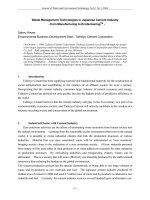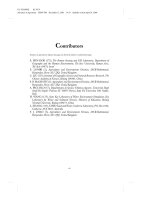information technologies in medicine, vol ii
Bạn đang xem bản rút gọn của tài liệu. Xem và tải ngay bản đầy đủ của tài liệu tại đây (3.5 MB, 204 trang )
INFORMATION
TECHNOLOGIES
IN MEDICINE
Information Technologies in Medicine, Volume II: Rehabilitation and Treatment.
Edited by Metin Akay, Andy Marsh
Copyright ( 2001 John Wiley & Sons, Inc.
Print ISBN 0-471-41492-1 Electronic ISBN 0-471-20645-8
INFORMATION
TECHNOLOGIES
IN MEDICINE
VOLUME II: REHABILITATION AND
TREATMENT
Edited by
Metin Akay
Dartmouth College
Andy Marsh
National Technical University of Athens
a wiley-interscience publication
JOHN WILEY & SONS, INC.
New York
.
Chichester
.
Weinheim
.
Brisbane
.
Singapore
.
Toronto
Designations used by companies to distinguish their products are often claimed as trademarks. In
all instances where John Wiley & Sons, Inc., is aware of a claim, the product names appear in
initial capital or all capital letters. Readers, however, should contact the appropriate
companies for more complete information regarding trademarks and registration.
Copyright ( 2001 by John Wiley & Sons, Inc. All rights reserved.
No part of this publication may be reproduced, stored in a retrieval system or transmitted in any
form or by any means, electronic or mechanical, including uploading, downloading, printing,
decompiling, recording or otherwise, except as permitted under Sections 107 or 108 of the 1976
United States Copyright Act, without the prior written permission of the Publisher. Requests to
the Publisher for permission should be addressed to the Permissions Department, John Wiley &
Sons, Inc., 605 Third Avenue, New York, NY 10158-0012, (212) 850-6011, fax (212) 850-6008,
E-Mail:
This publication is designed to provide accurate and authoritative information in regard to the
subject matter covered. It is sold with the understanding that the publisher is not engaged in
rendering professional services. If professional advice or other expert assistance is required, the
services of a competent professional person should be sought.
ISBN 0-471-20645-8
This title is also available in print as ISBN 0-471-41492-1.
For more information about Wiley products, visit our website at www.Wiley.com.
CONTRIBUTORS
Luciano Beolchi, European Commission DGXIII-C4, O½ce BU29-3/68, Rue
de la Loi 200 B-1049, Brussels, Belgium
Alberto Bianchi, LBHL, 50A-1148, 1 Cyclotron Road, University of Califor-
nia, Berkeley, CA 94720
Curtis Boswell, Jet Propulsion Laboratory, California Institute of Technology,
4800 Oak Grove Drive, Pasadena, CA 91109
Hari Das, Jet Propulsion Laboratory, California Institute of Technology, 4800
Oak Grove Drive, Pasadena, CA 91109
Mark Draper, Human Interface Technology Laboratory, Box 352142, Uni-
versity of Washington, Seattle, WA 98195-2142
Thomas A. Furness, III, Human Interface Technology Laboratory, Box 352142,
University of Washington, Seattle, WA 98195-2142
Roberto Gori, LBHL, 50A-1148, 1 Cyclotron Road, University of California,
Berkeley, CA 94720
Qinglian Guo, Department of Information Science, Faculty of Science, Uni-
versity of Tokyo, 7-3-1 Hongo, Bunkyo-ku, Tokyo 113-0033, Japan
Walter J. Greenleaf, Greenleaf Medical Systems, 2248 Park Boulevard, Palo
Alto, CA 94306
Claudio Lamberti, LBHL, 50A-1148, 1 Cyclotron Road, University of Cali-
fornia, Berkeley, CA 94720
Zsolt Lorant, 9904 Carlyle Way W Apt.a446, Mobile, AL 36609
Claudio Marchetti, LBHL, 50A-1148, 1 Cyclotron Road, University of Cali-
fornia, Berkeley, CA 94720
v
Katsunobu Muroi, Mitsubishi Electric Corporation, Tsukaguchi-Honmachi,
Amagasaki, Hyogo, JAPAN
Tim Ohm, Jet Propulsion Laboratory, California Institute of Technology, 4800
Oak Grove Drive, Pasadena, CA 91109
Mieko Ohsuga, Mitsubishi Electric Corporation, Tsukaguchi-Honmachi,
Amagasaki, Hyogo, JAPAN
Guiseppe Riva, Instituto Auxologico Italiano, Applied Technology for Neuro-
Psychology, Verbania, Italy
Guillermo Rodriguez, Jet Propulsion Laboratory, California Institute of Tech-
nology, 4800 Oak Grove Drive, Pasadena, CA 91109
Alessandro Sarti, LBHL, 50A-1148, 1 Cyclotron Road, University of Califor-
nia, Berkeley, CA 94720
Rob Steele, Jet Propulsion Laboratory, California Institute of Technology,
4800 Oak Grove Drive, Pasadena, CA 91109
Robert John Stone, Virtual Presence Ltd., Chester House, 79 Dane Road, Sale,
Cheshire, M33 7BP UK
Erik Viirre, 3081 Nute Way, San Diego, CA 92117
Jihong Wang, Department of Radiology, University of Texas Southwestern
Medical School, Dallas, TX 75235-9071
Brenda K. Wiederhold, Center for Advanced Multimedia Psychotherapy, CSPP
Research and Service Foundation, 6160 Cornerstone Court East, San Diego,
CA 92121
Mark D. Wiederhold, Department of Internal Medicine, Scripps Clinic Medi-
cal Group, 1200 Prospect Street, Suite 400, La Jolla, CA 92037
mark
vi CONTRIBUTORS
CONTENTS
PREFACE ix
PART I TREATMENT 1
1. Neuro/Orthopedic Rehabilitation and Disability Solutions Using
Virtual Reality Technology
Walter J. Greenleaf 3
2. The Use of Virtual Reality Technology in the Treatment of
Anxiety Disorders
Brenda K. Wiederhold and Mark D. Wiederhold 19
3. Virtual Reality for Health Care
L. Beolchi and G. Riva 39
4. Robot-Assisted Microsurgery Development at JPL
Hari Das, Tim Ohm, Curtis Boswell, Rob Steele, and Guillermo Rodriguez 85
5. Virtual Reality and the Vestibular System: A Brief Review
Erik Viirre, Zsolt Lorant, Mark Draper, and Thomas A. Furness, III 101
PART II TELEMEDICINE AND TELESURGERY 109
6. Computer Imagery and Multimedia Techniques for Supporting
Telemedicine Diagnoses
Qinglian Guo, Katsunobu Muroi, and Mieko Ohsuga 111
7. Implementing a Picture-Achieving and Communication System
(PACS) and Teleradiology System: Practical Issues and
Considerations
Jihong Wang 141
8. From Engineering to Surgery: The Harsh Realities of Virtual Reality
Robert John Stone 165
vii
9. Maxillofacial Virtual Surgery from 3-D CT Images
Alessandro Sarti, Roberto Gori, Alberto Bianchi, Claudio Marchetti, and
Claudio Lamberti
183
INDEX 201
viii CONTENTS
PREFACE
For many patients, the real world is too risky or disconcerting for them to move
around in. The agoraphobic patient has a fear of open or public places and so
may become housebound. The psychiatric technique of desensitization has been
in use for a number of years. The patient is asked to imagine the things that
are most disturbing and gradually their fears are controlled. Now a virtual
environment can be created for treatment of these patients. They can gradually
experience their feared objects in a manner with complete control. Similarly,
people who need rehabilitation from weakness or loss of body function or
control can have a custom environment created for them that will represent an
appropriate challenge to help them recover.
Delivery of medical care has be progressively hampered by the lack of ability
to provide specialized information uniformly to all people. Specialists tend to
be located in university, urban centers that are distant from many patients
and their primary care physicians. With the explosion of understanding of
many diseases, the primary care physician will need more and more access to
agents able to understand and synthesize information about patients.
Beyond telemedicine, telesurgery has been touted as a means of getting sur-
geon to a remote location and allowing him to operate on his patient. Since
there are many surgeons, this application of telepresence will only be useful in
places that doctors are not willing to go, such as the battle®eld. However, there
are remote locations that no surgeon is currently able to go; microscopic sites
inside the body. Surgeons now manipulate blood vessels inside the eye or bones
in the middle ear. However, at current size, even when viewed through the best
microscope, the VRT can also be used in the areas of physical disabilities. Vir-
tual environments can be created for the treatment of the patients with the
motor disturbances such as parases. The speech disabilities can be assisted by
simply using the data gloves which translate the gestures into spoken words.
In this volume, we will discuss the use of information technologies in in the
rehabilitation, treatment of physical disabilities in details and the delivery of
health care using the information technologies.
The ®rst chapter by W. J. Greenleaf summarizes the current status of the
virtual reality technologies and discusses the use of these technologies in neuro/
orthopedic rehabilitation as well as the new systems under development.
The second chapter by B. K. Wiederhold and M. D. Wiederhold gives the
use of virtual reality technologies for the treatment of many anxiety disorders
including fear of heights, ¯ying, spiders, driving, social phobia, and the possi-
ix
bility of using these technologies for the treatment of acute stress disorders and
generalized anxiety disorders.
The third chapter by L. Beolchi and G. Riva gives an indepth summary of
virtual reality technologoies and their applications in health care as well as the
healt care market analysis.
The fourth chapter by Das et al. presents the recenty developed RAM tele-
robot system and its demonstration of a simulated microsurgery procedure
performed at the JPL.
The ®fth chapter by Viirre et al. discusses motion sickness caused by the
virtual reality technology and the application of VR for vestibular patients.
The sixth chapter by Guo et al. introduces a telemedicine diagnosis support
systems based on the computer graphics and multimedia technologies.
The seventh chapter by J. Wang presents the implementation of a picture-
achieving and comunication system (PACS) and teleradiology system by em-
phasing the practical issues in the implementation of a clinical PACS.
The eighth chapter by Stone discusses the adoptation of virtual reality tech-
nologies in medicine and other sectors and presents a case study of one surgical
training system.
The last chapter by Sarti et al. discusses a simulation method that allows one
to deal with extremely complex anatomical geometrics and gives a detailed
comparison between virtual and real surgical opertions performed on patients.
We thank the authors for their valuable contributions to this volume and
George Telecki, the Executive Editor and Shirley Thomas, Senior Associate
Managing Editor of John Wiley & Sons, Inc. for their valuable support and
encouragement througout the preparation of this volume.
Metin Akay
This work was partially supported by a USA NSF grant (IEEE EMBS Work-
shop on Virtual Reality in Medicine, BES ± 9725881) made to Professor Metin
Akay.
x PREFACE
INFORMATION
TECHNOLOGIES
IN MEDICINE
PART I
TREATMENT
Information Technologies in Medicine,Volume II: Rehabilitation and Treatment.
Edited by Metin Akay, Andy Marsh
Copyright © 2001 John Wiley & Sons, Inc.
Print ISBN 0-471-41492-1 Electronic ISBN 0-471-20645-8
CHAPTER 1
Neuro/Orthopedic Rehabilitation and
Disability Solutions Using Virtual
Reality Technology
WALTER J. GREENLEAF, Ph.D.
Greenleaf Medical Systems
Palo Alto, California
1.1 VR Environments and Interfaces
1.1.1 Head-Mounted Display
1.1.2 Instrumented Clothing
1.1.3 3-D Spatialized Sound
1.1.4 Other VR Interfaces
1.2 Diversity of VR Applications
1.3 Current Status of VR Technology
1.4 VR-Based Medical Applications in Development
1.4.1 Surgical Training and Planning
1.4.2 Medical Education, Modeling, and Nonsurgical Training
1.4.3 Anatomically Keyed Displays with Real-Time Data Fusion
1.4.4 Telesurgery and Telemedicine
1.5 Neurologic Testing and Behavioral Intervention
1.6 Rehabilitation, Functional Movement Analysis, and Ergonomic Studies
1.6.1 The Role of VR in Disability Solutions
1.7 Conclusion
References
Virtual reality (VR) is an emerging technology that allows individuals to ex-
perience three-dimensional (3-D) visual, auditory, and tactile environments.
Highly specialized sensors and interface devices allow the individual to become
3
Information Technologies in Medicine, Volume II: Rehabilitation and Treatment, Edited by
Metin Akay and Andy Marsh.
ISBN 0-471-41492-1 ( 2001 John Wiley & Sons, Inc.
immersed and to navigate and interact with objects in a computer-generated
environment. Most people associate VR with video games; however, researchers
and clinicians in the medical community are becoming increasingly aware of its
potential bene®ts for people with disabilities and for individuals recovering
from injuries.
1.1 VR ENVIRONMENTS AND INTERFACES
The computer-generated environment, or virtual world, consists of a 3-D
graphics program that relies on a spatially organized, object-oriented database
in which each object in the database represents an object in the virtual world
(Fig. 1.1). A separate modeling program is used to create the individual objects
for the virtual world. For greater realism, these modeling programs apply state-
of-the-art computer-graphics techniques, such as texture mapping and shading,
to all of the objects of the scene. The object database is manipulated using a
real-time dynamics controller that speci®es how objects behave within the
world according to user-speci®ed constraints and according to natural laws,
such as gravity, inertia, and material properties. These laws are application
speci®c. The dynamics controller also tracks the position and orientation of the
user's head and hand.
Figure 1.1. A Complete VR system HMD, head-mounted display.
4
NEURO/ORTHOPEDIC REHABILITATION AND DISABILITY SOLUTIONS
Common computer input devices, such as a mouse and a keyboard, do not
provide a sense of immersion in a virtual world. To create a VR experience, the
conventional computer interface is replaced by one that is more natural and
intuitive for interaction within complex 3-D environments. The need for im-
proved human±computer interaction with virtual environments (VEs) has mo-
tivated the development of a new generation of interface hardware. To date, the
most common 3-D input devices used in VR applications are head-mounted
displays (HMDs) and instrumented clothing (gloves and suits). VEs may also
be created through circuambiant projections (1), 3-D spatialized sound (2),
haptic feedback, and motion e¨ectors.
1.1.1 Head-Mounted Display
The best-known tool for data output in VR is the head-mounted display. It
supports ®rst-person immersion by generating a wide ®eld of view image for
each eye, often in true 3-D. Most lower-cost HMDs ($1000 range) use liquid
crystal displays (LCDs) others use small cathode ray tubes (CRTs). The more
expensive HMDs ($60,000 and up) use optical ®bers to pipe the images from
non-HMDs. An HMD requires a position tracker in addition to the helmet.
Alternatively, the binocular display can be mounted on an armature for sup-
port and tracking (a Boom display) (3).
1.1.2 Instrumented Clothing
Among the most popular and widely available input devices for VR are hand-
tracking technologies. Such glove-based input devices let VR users apply their
manual dexterity to the VR activity. Hand-tracking gloves currently in use
include Sayre Glove, MIT LED Glove, Digital Data-Entry Glove, DataGlove,
Dexterous HandMaster, Power Glove, CyberGlove, and Space Glove (4). This
chapter describes two prototype clinical and rehabilitation applications using
instrumented clothing technology (Fig. 1.2).
Originally developed by VPL Research, the DataGlove is a thin cloth glove
with engraved optical ®bers running along the surface of each digit that loop
back to a light-processing box. The optical ®bers that cross each joint are
treated to increase the refractive surface area of that segment of the ®ber over
the joint. Each optical ®ber originates at, and returns to, a light-processing box.
In the light-processing box, light-emitting diodes send photons along the ®bers
to the photo detector. When the joints of the hand bend, the optical ®bers bend
so that the photons refract out of the ®ber, thus attenuating the signal that
passes through the ®bers. The transmitted signal is proportional to the amount
of ¯exion of a single joint and is recorded as such.
Because the attenuation of light along each optical ®ber is interpreted as a
measurement of joint ¯exion, the set of joint measurements can be thought of as
a hand gesture. To provide feedback to the user, most VR applications render a
graphic representation of the hand moving in real time; this representation
1.1 VR ENVIRONMENTS AND INTERFACES 5
shadows the movements of the hand in the DataGlove and replicates even the
most subtle actions.
To determine the orientation and the position of the hand in 3-D space, the
glove relies on a spatial tracking system. Tracking systems usually rely on
electromagnetic, ultrasonic, or infrared sensors to determine the position and
orientation of a the glove in relation to the signal source. Typically, the source
is placed at a desired point of reference and the sensor is mounted on the
dorsum of the glove.
The DataSuit is a custom-tailored body suit ®tted with the same sophisti-
cated ®beroptic sensors found in the DataGlove. The sensors are able to track
the full range of motion of the person wearing the DataGlove or DataSuit as he
or she bends, moves, grasps, or waves. Missing from the instrumented clothing
is haptic feedback, which provides touch and force-feedback information to the
VR participant.
1.1.3 3-D Spatialized Sound
The impression of immersion within a VE is greatly enhanced by inclusion of
3-D spatialized sound (5). Stereo-pan e¨ects alone are inadequate because they
tend to sound as if they are originating inside the head. Research into 3-D
audio has shown the importance of modeling the head and pinna and using this
model as part of the 3-D sound generation. A head-related transfer function
Figure 1.2. The WristSystem, based on the VR DataGlove.
6
NEURO/ORTHOPEDIC REHABILITATION AND DISABILITY SOLUTIONS
(HRTF) can be used to generate the proper acoustics. A number of problems
remain, such as the cone of confusion, wherein sounds behind the head are
perceived to be in front of the head.
1.1.4 Other VR Interfaces
Senses of balance and motion can be generated in a VR system by a motion
platform. These have been used in ¯ight simulators to provide motion cues that
the mind integrates with other cues to perceive motion. Haptics is the gen-
eration of touch and force-feedback information. Most systems to date have
focused on force feedback and kinesthetic senses, although some prototype
systems exist that generate tactile stimulation. Many of the haptic systems thus
far are exoskeletons used for position sensing as well as for providing resistance
to movement or active force application.
Some preliminary work has been conducted on generating the sense of tem-
perature in VR. Small electrical heat pumps have been developed that produce
sensations of heat and cold as part of the simulated environment.
1.2 DIVERSITY OF VR APPLICATIONS
VR has been researched for decades in government laboratories and uni-
versities, but because of the enormous computing power demands and asso-
ciated high costs, applications have been slow to migrate from the research
world to other areas. Recent improvements in the price:performance ratio of
graphic computer systems have made VR technology more a¨ordable and
thus used more commonly in a wider range of applications. In fact, there is even
a strong ``garage VR'' movementÐgroups of interested parties sharing infor-
mation on how to build extremely low cost VR systems using inexpensive o¨-
the-shelf components (6). These homemade systems are often ine½cient, un-
comfortable to use (sometimes painful), and slow; but they exist as a strong
testament to a fervent interest in VR technology.
Current VR applications are diverse and represent dramatic improvements
over conventional visualization and planning techniques:
.
Public entertainment. VR is arguably the most important current trend in
public entertainment, with ventures ranging from shopping mall game
simulators to low-cost VR games for the home.
.
Computer-aided design (CAD). Using VR to create virtual prototypes in
software allows engineers to test potential products in the design phase,
even collaboratively over computer networks, without investing time or
money for conventional hard models.
.
Military. Using VR, the military's solitary cab-based systems have evolved
into extensive networked simulations involving a variety of equipment
and situations. Extensive battle simulations can now be created that net-
1.2 DIVERSITY OF VR APPLICATIONS 7
work tanks, ships, soldiers, and ®ghters all into the same shared training
experience.
.
Architecture and construction. VR allows architects and engineers and
their clients to walk through structural blueprints. Designs may be under-
stood more clearly by clients who often have di½culty comprehending even
conventional cardboard models. The city of Atlanta credits its VR model
for winning the site of the 1996 Olympics, and San Diego used a VR model
of a planned convention center addition to compete for (and obtain) the
1996 Republican Party convention.
.
Financial visualization. By allowing navigation through an abstract world
of data, VR helps users rapidly visualize large amounts of complex ®nan-
cial market data and thus supports faster decision making.
VR is commonly associated with exotic fully immersive applications because of
the overdramatized media coverage of helmets, body suits, entertainment sim-
ulators, and the like. As important are the window-into-world applications by
which the user or operator is allowed to interact e¨ectively with virtual data,
either locally or remotely.
1.3 CURRENT STATUS OF VR TECHNOLOGY
The commercial market for VR, although taking advantage of advances in VR
technology at large, is nonetheless contending with the lack of integrated sys-
tems and the lack of reliable equipment suppliers. Typically, researchers buy
peripherals and software from separate companies and con®gure their own
systems. Companies that can o¨er integrated systems for commercial applica-
tions are expected to ®ll this gap over the next few years. Concurrently, the
nature of the commercial VR medical market is expected to change as the
prices of today's expensive, high-performance graphics systems decrease dra-
matically. High-resolution display systems will also signi®cantly drop in cost
as the VR display business can piggyback on HDTV projection and home-
entertainment technologies.
Technical advances have occurred in networking applications, which include
improved visual photo realism, decreased tracker latency through predictive
algorithms, and variable resolution image generators. Work to improve data-
base access methods is under way. Important hardware advances include eye
gear with an increased ®eld of view, wireless communications, lighted and
smaller devices, and improved tracking systems.
1.4 VR-BASED MEDICAL APPLICATIONS IN DEVELOPMENT
The ®rst wave of VR development e¨orts in the medical community addressed
seven key categories:
8 NEURO/ORTHOPEDIC REHABILITATION AND DISABILITY SOLUTIONS
Surgical training and surgical planning.
Medical education, modeling, and nonsurgical training.
Anatomically keyed displays with real-time data fusion.
Telesurgery and telemedicine.
Patient testing and behavioral intervention.
Rehabilitation, functional movement analysis, and motion/ergonomic
studies.
Disability solutions.
The potential of VR through education and information dissemination indi-
cates there will be few areas of medicine not taking advantage of this improved
computer interface. However, the latent potential of VR lies in its capacity to
be used to manipulate and combine heterogeneous datasets from many sources.
This feature is most signi®cant and likely to transform the traditional applica-
tions environment in the near future.
1.4.1 Surgical Training and Planning
Various projects are under way to use VR and imaging technology to plan,
simulate, and customize invasive (an minimally invasive) surgical procedures.
Ranging from advanced imaging technologies for endoscopic surgery to routine
hip replacements, these new developments will have a tremendous e¨ect on
improving surgical morbidity and mortality. According to Merril (7), studies
show that doctors are more likely to make errors when performing their ®rst
few to several dozen diagnostic and therapeutic surgical procedures then when
performing later procedures. Merril claims that operative risk could be sub-
stantially reduced by the development of a simulator that would allow trans-
ference of skills from the simulation to the actual point of patient contact. With
surgical modeling, we would generally expect a much higher degree of preci-
sion, reliability, and safety, in addition to cost e½ciency.
Several VR-based systems currently under development allow real-time
tracking of surgical instrumentation and simultaneous display and manipulation
of 3-D anatomy corresponding to the simulated procedure (8, 9). Using this
design, surgeons can practice procedures and experience the possible complica-
tions and variations in anatomy encountered during surgery. Necessary soft-
ware tools have been developed to enable the creation of virtual tissues that
re¯ect the physical characteristics of physiologic tissues. This technology oper-
ates in real-time using 3-D graphics, on a high-speed computer platform.
1.4.2 Medical Education, Modeling, and Nonsurgical Training
Researchers at the University of California at San Diego are exploring the
value of hybridizing elements of VR, multimedia (MM), and communications
technologies into a uni®ed educational paradigm (10). The goal is to develop
1.4 VR-BASED MEDICAL APPLICATIONS IN DEVELOPMENT 9
powerful tools that extend the ¯exibility and e¨ectiveness of medical teaching
and promote lifelong learning. To this end, they have undertaken a multiyear
initiative, named the VR-MM Synthesis Project. Based on instructional design
and user need (rather than technology per se), they plan to link the computers
of the Data Communications Gateway, the Electronic Medical Record System,
and the Simulation Environment. This system supports medical students, sur-
gical residents, and clinical faculty and runs applications ranging from full
surgical simulation to basic anatomic exploration and review, all via a common
interface. The plan also supports integration of learning and telecommunica-
tions resources (such as interactive MM libraries, on-line textbooks, databases
of medical literature, decision support systems, email, and access to electronic
medical records).
1.4.3 Anatomically Keyed Displays with Real-Time Data Fusion
An anatomically keyed display with real-time data fusion is currently in use
at the New York University Medical Center's Department of Neurosurgery.
The system allows both preoperative planning and real-time tumor visualiza-
tion (11, 12). The technology o¨ers the opportunity for a surgeon to plan and
rehearse a surgical approach to a deep-seated, centrally located brain tumor
before doing of the actual procedure. The imaging method (volumetric stereo-
taxis) gathers, stores and reformats imaging-derived, 3-D volumetric informa-
tion that de®nes an intracranial lesion (tumor) with respect to the surgical ®eld.
Computer-generated information is displayed during the procedure on com-
puter monitors in the operating room and on a heads-up display mounted on
the operating microscope. These images provide surgeons with CT- and MRI-
de®ned maps of the surgical ®eld scaled to actual size and location. This infor-
mation guides the surgeon in ®nding and de®ning the boundaries of brain
tumors. The computer-generated images are indexed to the surgical ®eld by
means of a robotics-controlled stereotactic frame that positions the patient's
tumor within a de®ned targeting area.
Simulated systems using VR models are also being advocated for other high-
risk procedures, such as the alignment of radiation sources to treat cancerous
tumors.
1.4.4 Telesurgery and Telemedicine
Telepresence is the sister ®eld of VR. Classically de®ned as the ability to act and
interact in an o¨-site environment by making use of VR technology, tele-
presence is emerging as an area of development in its own right. Telemedicine
(the telepresence of medical experts) is being explored as a way to reduce the
cost of medical practice and to bring expertise into remote areas (13, 14).
Telesurgery is a fertile area for development. On the verge of realization,
telesurgery (remote surgery) will help resolve issues that can complicate or
compromise surgery, including
10 NEURO/ORTHOPEDIC REHABILITATION AND DISABILITY SOLUTIONS
.
A patient that is too ill or injured to be moved for surgery.
.
A specialized surgeon located at some distance from the patient who
requires specialized intervention.
.
Accident victims who need immediate, on-the-scene surgery.
.
Soldiers wounded in battle.
The surgeon really does operateÐon ¯esh, not a computer animation. Although
the distance aspect of remote surgery is a provocative one, telepresence is proving
to be an aid in nonremote surgery as well. It can help surgeons gain dexterity
and improve their operative technique, which is expected to be particularly
important in endoscopic surgery. For example, suturing and knot tying will be
as easy to see in endoscopic surgery as it is in open surgery, because telepres-
ence o¨ers the ability to emulate the look and feel of open surgery.
As initially developed at SRI International (15), telepresence not only o¨ers
a compelling sense of reality for the surgeon but also allows him or her to per-
form the surgery according to the usual methods and procedures. There is
nothing new to learn. Hand motions are quick and precise. The visual ®eld, the
instrument motion, and the force feedback can all be scaled to make micro-
surgery easier than it would be if the surgeon were at the patient's side. While
current technology has been implemented in several prototypes, SRI and Tele-
surgical Corporation (Redwood City, CA) are collaborating to develop a full
comercial system based on this novel concept.
1.5 NEUROLOGIC TESTING AND BEHAVIORAL INTERVENTION
For Parkinson disease victims, initiating and sustaining walking becomes
progressively di½cult. The condition known as akinesia can be mitigated by
treatment with drugs such as l-dopa, a precursor of the natural neural trans-
mitter dopamine, but usually not without unwanted side e¨ects. Now, collabo-
rators at the Human Interface Technology Laboratory and the Department
of Rehabilitation Medicine at the University of Washington, along with the
San Francisco Parkinson's Institute are using virtual imagery to simulate an
e¨ect called kinesia paradoxa, or the triggering of normal walking behavior in
akinetic Parkinson patients (16).
Using a commercial, ®eld-multiplexed, heads-up video display, the research
team has developed an approach that elicits near-normal walking by presenting
collimated virtual images of objects and abstract visual cues moving through
the patient's visual ®eld at speeds that emulate normal walking. The combina-
tion of image collimation and animation speed reinforces the illusion of space-
stabilized visual cues at the patient's feet. This novel, VR-assisted technology
may also prove to be therapeutically useful for other movement disorders.
Lamson and Meisner (17) investigated the diagnostic and treatment possi-
bilities of VR immersion on anxiety, panic and height phobias. By immersing
1.5 NEUROLOGIC TESTING AND BEHAVIORAL INTERVENTION 11
both patients and controls in computer-generated situations, the researchers
were able to expose the subjects to anxiety-provoking situations (such as
jumping from a height) in a controlled manner. Experimental results indicate a
signi®cant subject habituation and desensitization through this approach, and
the approach appears clinically useful.
Pugnetti (18) explored the potential of enhancing the clinical evaluation and
management of acquired cognitive impairments in adults. By using a VR-based
navigation paradigm, researchers were able to challenge both patients and
normal subjects with a complex cognitive activity and simultaneously generate
performance data. Behavioral data analysis was then carried out using estab-
lished scoring criteria.
1.6 REHABILITATION, FUNCTIONAL MOVEMENT ANALYSIS, AND
ERGONOMIC STUDIES
The ®eld of VR is still at the proof-of-concept stage, yet there is a growing
number of potential applications related to motion monitoring, rehabilitation,
and ergonomic analysis. I (19) theorized that the rehabilitation process can be
enhanced through the use of VR technology.
Evaluation of hand impairment involves detailed physical examination and
functional testing of the a¿icted person. The physical examination is designed
to determine the presence of pain and any loss of strength, sensation, range of
motion, and structure. The results are combined to produce a numerical as-
sessment of impairment that is used to evaluate the patient's progress over time,
yet examinations and calculations can be time-consuming, expensive, and sub-
ject to observer error.
Functional evaluation is usually accomplished by subjective observation of
patient performance on standardized tests for motor skills. However, repro-
ducibility of measurements becomes an issue whenever di¨erent examiners
evaluate the same patient, which makes it di½cult to evaluate a patient's prog-
ress over time. The more objective assessments of upper extremity motion fall
into two categories: visual and e¨ective.
Visual methods involve digitizing and estimating a visual record of the
motion: The patient is videotaped performing a task; then the individual frames
of the video are digitized and evaluated to quantify the degree of motion of
the joint under study. The main limitation of this technique is that the camera
can view motion in only two dimensions. To assess movement in the camera's
visual plane accurately, the third dimension must be held constant, i.e., the
person must move along a known line parallel to the plane of the ®lm in the
camera. In most cases, the examiner cannot maintain the correct orientation
even for short periods, making this a di½cult and cumbersome technique.
E¨ective methods measure the motion's e¨ect rather than the motion itself.
A work simulator is one example of an e¨ective assessment tool. Work simu-
lators measure the force exerted by a subject on a variety of attachments that
12 NEURO/ORTHOPEDIC REHABILITATION AND DISABILITY SOLUTIONS
simulate tools used in the workplace. A major limitation of this approach is
that no data are collected on how the person e¨ects the force.
Ideally one would like to collect and compare range of motion data for a
joint in several planes simultaneously while speci®c tasks were being performed
by the patient, a measurement that is impossible using a standard goniometer.
At one point my group considered using the DataGlove with its multiple sen-
sors as a means of collecting dynamic functional movement data. However,
migrating the DataGlove technology from the ®eld of VR to clinical evaluation
posed several problems. For example, during manufacture of the DataGlove,
the treatment of individual ®beroptic cables was not identical, thus it was
impossible to characterize and predict their behavior. Moreover, empirical ob-
servations show hysteresis, making repeated measurements irreproducible and
making it di½cult to determine the accuracy of the measurements. For highly
accurate measurements, it is important to have a perfect ®t of the glove, be-
cause poor placement of the sensitive areas of ®bers yields incorrect measure-
ments. Achieving a perfect ®t of the DataGlove posed a serious challenge
because of the variability of hand shapes and sizes across a given patient
population. Moreover, the use of the ®beroptic DataGlove excluded the popu-
lation of patients with anatomic deformities.
With the goal of obtaining accurate, dynamic range of motion data for the
wrist joint, my group investigated other sensor materials and developed the
glove-based WristSystem. Fiberoptic sensors were replaced by dual-axis elec-
trogoniometric sensors that could be inserted into machine-washable Lycra
gloves that ®t di¨erent sizes of hands.
WristSystem gloves are currently being used to track ¯exion, extension,
radial, and ulnar deviations of the wrist while patients are performing routine
tasks. A portable, lightweight DataRecorder worn in a waist pack permits the
patient to be ambulatory while data are being collected at the clinic or work site
(Fig. 1.3); no visual observation or supervision is required beyond the initial
calibration of the glove sensors. Real-time visual and auditory feedback can
also be used to train the patient to avoid high-risk postures in the workplace or
at home.
The WristSystem includes Motion Analysis System (MAS) software for the
interpretation of the dynamic-movement data collected by the DataRecorder
over several minutes or hours. This software o¨ers rapid, quantitative analysis
of data that includes the total and percent time the wrist spends at critical an-
gles (minimum, maximum, and mean wrist angles in four directions), the num-
ber of repetitions, and the velocity and acceleration. Figure 1.4 shows a sample
plot of some of these data. In this example, it can be seen that the patient's right
hand was ulnar-deviated >15
for 84% of the time he performed a certain task.
The WristSystem is currently being used by occupational and rehabilitation
medicine specialists (MDs, PTs, and OTs), ergonomists, industrial safety man-
agers, biomechanical researchers, and risk management consultants. The ulti-
mate extension of this project is to build an augmented-reality environment for
quantitative evaluation of functional tasks. The system will link multiple input
1.6 REHABILITATION, FUNCTIONAL MOVEMENT ANALYSIS, AND ERGONOMIC STUDIES 13
devices or sensors worn by the patient and 3-D modeling software. Therapists
will be able to design a virtual world composed of objects traditionally used in
functional assessment tests, such as balls, cubes, keys, and pencils. The therapist
will be able to record the motion, location, and trajectory of the user's hand
that is required to accomplish the motion and any associated hand tremors or
Figure 1.3. The WristSystem being used to track functional movement at a job site.
Figure 1.4. MAS: WristSystem data plot.
14
NEURO/ORTHOPEDIC REHABILITATION AND DISABILITY SOLUTIONS
spasms. Once the data are collected, the therapist can use statistical analysis
software to interpret them. The clinician can also elect to review the motions by
animation of the data and to change the orientation to study the motion from
another angle.
Other control devices originally developed for VR are being improved and
applied to the ®eld of functional evaluation of movement in a variety of ways.
Burdea (20) described a system that would couple a glove with force-feedback
devices to rehabilitate a damaged hand or to diagnose a range of hand prob-
lems. He describes another system under development that incorporates tactile
feedback in a glove to produce feeling in the ®ngers when virtual objects are
``touched.''
My research group previously theorized that the rehabilitation process could
be enhanced through the use of VR technology (21). Perhaps the most signi®-
cant advantage is that a single VR-based rehabilitation workstation can be
easily customized for individual patient needs. We are currently developing some
basic components for a VR-based workstation (Fig. 1.5) that will be used to
.
Restructure the rehabilitation process into small, incremental functional
steps.
Figure 1.5. Virtual reality technology for quanitative evaluation of functional tasks.
1.6 REHABILITATION, FUNCTIONAL MOVEMENT ANALYSIS, AND ERGONOMIC STUDIES 15
.
Make the rehabilitation process more realistic and less boring, enhancing
patient motivation and recovery of function.
.
Facilitate home rehabilitation.
.
Provide an objective index of function for activities of daily living and
work.
1.6.1 The Role of VR in Disability Solutions
One exciting aspect of VR technology is the inherent ability to enable individ-
uals with physical disabilities to accomplish tasks and have experiences that
would otherwise be denied them. There are approximately 35 million people in
the United States who have physical disabilities that a¨ect their ability to work
in certain types of jobs. Computers and VR software can provide increased
access to daily activities for people with disabilities. VR technology may pro-
vide an adaptable mechanism for harnessing a person's strongest physical
ability to operate an input device for a computer program.
A simple glove-based system allows users to record custom-tailored gestures
and to map these gestures to actions. These actions can range from a simple
command, such as a mouse click on a computer screen, to more complex func-
tions, such as controlling a robotic arm. An application programmer can
de®ne the functional relationship between the sensor data and a task with real-
time graphical representation on a computer screen. Simple gestures can be
translated to a preprogrammed set of instructions for speech or movement.
The prototype GloveTalker is an example of a one-to-one mapping of a
gesture to a computer-generated action to provide additional communica-
tion skills to people with vocal impairment. The patient is able to speak by
signaling the computer with his or her personalized set of gestures while wear-
ing the DataGlove, which recognizes hand positions (gestures) and passes the
information to the computer's voice-synthesis system (Fig. 1.6). For example, a
patient may map a speci®c gesture, such as a closed ®st, for the phrase ``Hello,
my name is Susan.'' The computer has some freedom in interpreting the gesture
so that people capable of only relatively gross muscle control may use the
system. There is also the possibility of sending the voice output through a tele-
phone system, enabling vocally impaired individuals to communicate verbally
over distance.
1.7 CONCLUSION
VR tools and techniques are rapidly developing in the scienti®c, engineering,
and medical areas. Although traditionally used as input devices for virtual
worlds in the entertainment and defense industry, sensor-loaded gloves may
become the clinical tools of choice for measuring, monitoring, and amplifying
upper-extremity motion. Although I have identi®ed other potential clinical ap-
plications, many technological challenges must be met before such devices can
be made available for patient care.
16 NEURO/ORTHOPEDIC REHABILITATION AND DISABILITY SOLUTIONS









